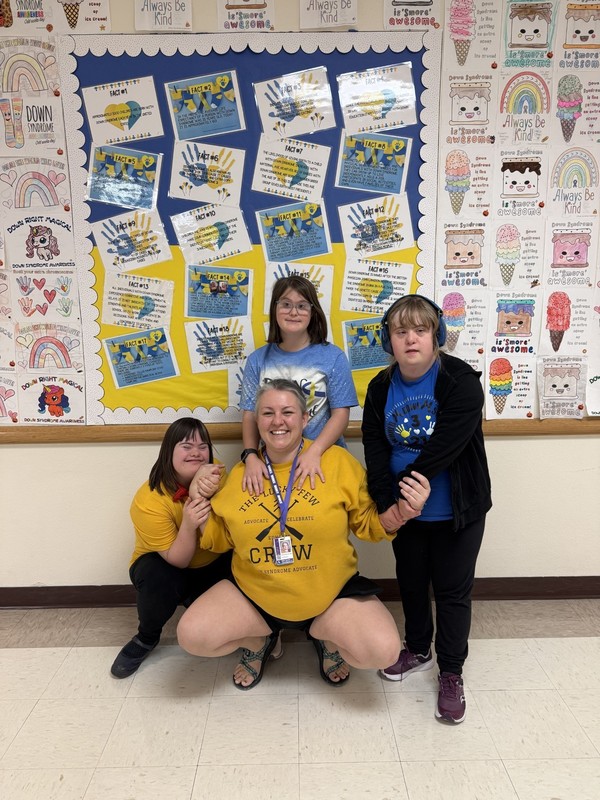October is Down Syndrome (DS) Awareness month, and the BFMS students and staff celebrated to the MAX! Every morning during announcements, student volunteers read interesting facts about DS to teach us what makes our special friends so amazing and special! During the weeks BFMS participated in a school wide coloring contest showing off creativity while raising awareness for people with DS. Mismatched and wacky socks were rocked daily warranting fun prizes and bringing up conversations on why we wore them. Do you know why DS awareness can be represented by socks? Down Syndrome is caused by and extra copy of the 21st chromosome, and under a microscope it looks just like a pair of socks! Lastly, we celebrated with our favorite classmates who have DS!! Senior, Emma Juelfs, made a video of her beautifully reading Taking Down Syndrome to School the book Taking Down Syndrome to School for the whole school to enjoy. Please click on the link to hear her story! Newly established high schoolers, Sadee Keil and Fara Bricker helped us celebrate too! Belle Fourche Middle School students and staff united with Emma, Sadee, and Fara in wearing yellow and/or blue for an exquisite school picture representing the power of love and awareness!!
Thank you to everyone at the Belle Fourche Middle School for participating in the exciting events and showing love and support for such an amazing group of people. A very special thank you to all the people who worked tirelessly behind the scenes to make the month of Down Syndrome awareness such a success!!!


 Please continue on to read our 21 facts we learned this month about Down Syndrome.
Please continue on to read our 21 facts we learned this month about Down Syndrome.
October is Down Syndrome Awareness Month! To us, that means an extra opportunity to spread awareness and celebrate the accomplishments of individuals with Down syndrome. Down syndrome is a genetic disorder caused by the presence of an extra copy of chromosome 21. Down syndrome is a disability, but it does not mean people with Down Syndrome have less value. Let’s change the way the world views Down syndrome!
Fact 1: Approximately 5000 children are born with Down syndrome in the United States each year.
Fact 2: In the 1980’s, the average life expectancy of a person with Down syndrome was 25 years old. Today it is roughly 60.
Fact 3: Individuals with Down syndrome have low muscle tone, also known as hypotonia. This is why it may take a little longer to crawl, sit up, talk, walk and eat the same foods as their peers.
Fact 4: Since the 1970’s, public schools are required by law to provide a free and appropriate education to children with Down syndrome.
Fact 5: There are many health conditions associated with Down syndrome. Heart defects, hearing loss, sleep apnea, autism, digestive tract conditions, and vision problems are a few. Health care providers continue to research and encourage proactive care.
Fact 6: Down syndrome is also known as Trisomy 21 or T21. This is because Down syndrome occurs when a person has three copies of the 21st chromosome.
Fact 7: The likelihood of giving birth to a child with Down syndrome increases with maternal age, however, 80% of babies with Down syndrome are born to women under age 35. This is because this age group gives birth most frequently.
Fact 8: While behavior, mental ability, and physical development varies from person to person, many individuals with Down syndrome grow up to live independently, hold a job and participate in social activities.
Fact 9:There are three types of Down syndrome: trisomy 21 (nondisjunction) accounts for 95% of cases, translocation accounts for about 4%, and mosaicism accounts for about 1%.
Fact 10: Children and adults with Down syndrome share some common features, but the individual most resembles their immediate family members.
Fact 11: Feeding can be challenging for babies, kids and adults with Down syndrome. This can be due to a combination of having low muscle tone in their jaw, tongue and lips which make it difficult to chew food, control their tongue, or suck liquids from a straw. Through medical intervention and therapy, individuals can build oral muscles and eat foods without difficulty.
Fact 12: People “have” Down syndrome, they do not “suffer from” it and are not “afflicted by” it. A person with Down syndrome is not “a Downs person.”
Fact 13: All individuals with Down syndrome experience cognitive and developmental delays. It is not indicative of their many strengths and talents as they still can attend school, go to work, participate in decisions that affect them, and contribute to society in many ways.
Fact 14: Some individuals with Down syndrome have what is called a single palmar crease in their hands. This is a result of their low muscle tone in the womb as their hand was not held in a tight fist. The single palmar crease can lead to challenges in developing fine motor skills, including handwriting or using eating utensils.
Fact 15: A few of the common physical traits of Down syndrome include small stature, head, ears, and mouth, upward slant to the eyes, a single deep crease across the center of the palm, or a short neck. Every person with Down syndrome is unique and may not possess all characteristics.
Fact 16: Down syndrome is named after the British physician John Langdon Down. He described the syndrome in 1866.
Fact 17: Diagnostic tests are performed after a positive screening test in order to confirm a Down syndrome diagnosis. There are currently three types of diagnostic tests which include: Chorionic villus sampling (CVS), Amniocentesis, and Percutaneous umbilical blood sampling (PUBS). These tests look for changes in the chromosomes that would indicate a Down syndrome diagnosis.
Fact 18: Children and adults with Down syndrome are likely to have challenges with weight gain. These individuals have slower growth patterns, hypothyroidism concerns, and lower metabolic rates which result in weight concerns. Sensible eating and regular exercise will help to encourage a healthy lifestyle.
Fact 19: Down syndrome has nothing to do with race, nationality, socioeconomic status, religion, or anything the mother or father did during pregnancy.
Fact 20: After learning of a Down syndrome diagnosis, caregivers and family members may experience a range of emotions. The best antidote is to offer support along with a congratulations. There are a variety of resources including early intervention programs, education, support groups, social/ leisure activities, and stress relief management to name a few. What many have experienced in timing, is the realization that their lives have just become enriched by the unexpected.
Fact 21: Individuals with Down syndrome are AMAZING and should be treated as such!

